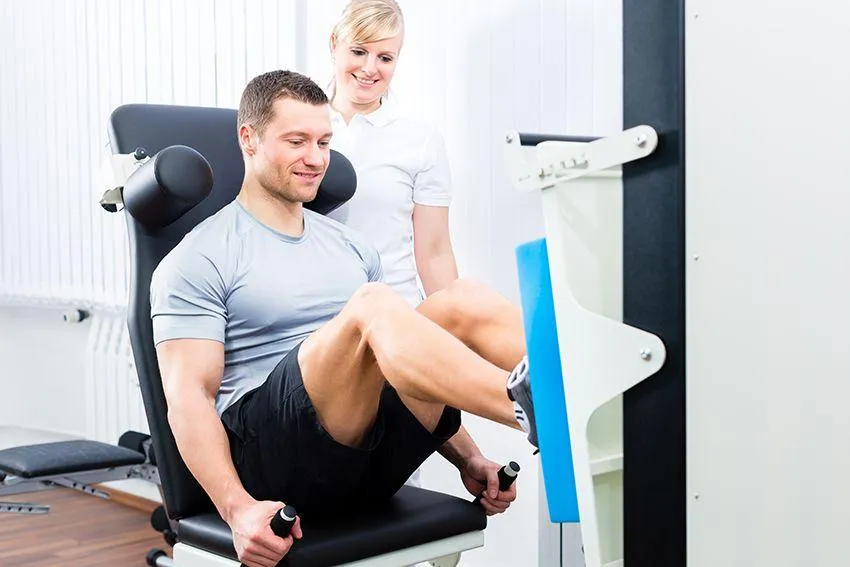Blogs

SI Joint Pain: Causes, Symptoms, Treatments
“ Don't let SI joint pain limit your life. Explore treatments, find relief, and embrace your mobility! ” - New Jersey Rehab Experts
Are you experiencing nagging pain in your lower back or hips? You may be suffering from SI joint pain. The sacroiliac (SI) joints are located in the pelvis and connect the sacrum (the triangular bone at the base of the spine) to the ilium (the large bones on either side of the pelvis). When these joints are inflamed or strained, they can cause significant discomfort and limit your mobility.
In this article, we will delve into the secrets of SI joint pain, exploring its causes, symptoms, and effective treatments. You will learn about the various factors that can contribute to SI joint pain, such as pregnancy, arthritis, or trauma, and how these issues can be diagnosed by medical professionals. We will also explore the common symptoms associated with SI joint pain, including pain in the lower back, buttocks, or groin, as well as difficulty standing or walking.
Finally, we will discuss the various treatment options available for SI joint pain, including physical therapy, medication, and in some cases, surgery. By understanding the causes, symptoms, and treatments for SI joint pain, you can take the necessary steps to find relief and regain control of your life.
Anatomy of the SI Joint
To understand SI joint pain, it is important to have a basic understanding of the anatomy of the SI joint. The sacroiliac joints are located in the pelvis, connecting the sacrum and the ilium. These joints are responsible for transferring the weight of the upper body to the lower body and allowing for stability during activities such as walking or running.
The SI joint is a synovial joint, which means it is surrounded by a joint capsule and contains synovial fluid to reduce friction between the bones. Ligaments and muscles provide additional stability to the joint. The unique shape and structure of the SI joint allow for minimal movement, primarily in the form of rotation and minimal tilting.
Common Causes of SI Joint Pain
SI joint pain can be caused by various factors, and understanding the underlying causes is crucial for effective treatment. One common cause of SI joint pain is pregnancy. During pregnancy, hormonal changes occur that loosen the ligaments in the pelvis, preparing the body for childbirth. This increased mobility in the SI joint can lead to instability and pain.
Arthritis is another common cause of SI joint pain. Osteoarthritis, a degenerative joint disease, can affect the SI joint and lead to inflammation and pain. Rheumatoid arthritis, an autoimmune disease, can also target the SI joint and cause significant discomfort.
Trauma or injury to the SI joint can result in pain as well. Falls, accidents, or repetitive activities that put stress on the joint can lead to inflammation and strain. In some cases, previous surgeries or spinal fusion procedures can also contribute to SI joint pain.
Symptoms of SI Joint Dysfunction
SI joint pain can manifest in various ways, and recognizing the symptoms is essential for proper diagnosis and treatment. The most common symptom of SI joint dysfunction is pain in the lower back, buttocks, or groin. The pain may be sharp or dull and may worsen with certain movements, such as standing up from a seated position or climbing stairs.
In addition to pain, individuals with SI joint dysfunction may experience difficulty standing or walking for extended periods. The pain may radiate down the leg and mimic symptoms of sciatica. Some individuals may also notice a feeling of instability in the pelvis or have difficulty finding a comfortable position when sitting or lying down.
It is important to note that SI joint pain can often be misdiagnosed or overlooked, as the symptoms may mimic other conditions such as herniated discs or hip issues. If you are experiencing persistent pain in the lower back or hips, it is important to consult with a medical professional for an accurate diagnosis.
Diagnosing SI Joint Pain
Diagnosing SI joint pain can be challenging, as the symptoms can overlap with other conditions. However, there are several methods that medical professionals use to determine if the SI joint is the source of pain.
One common diagnostic tool is a physical examination. The doctor may perform specific tests to assess the mobility and stability of the SI joint. These tests may involve applying pressure to the joint or asking the patient to perform certain movements that reproduce the pain.
Imaging studies, such as X-rays or MRI scans, can also provide valuable information. X-rays can help identify any structural abnormalities or signs of arthritis in the SI joint. MRI scans can provide detailed images of the soft tissues surrounding the joint, helping to rule out other potential causes of pain.
In some cases, a diagnostic SI joint injection may be performed. This procedure involves injecting a local anesthetic and a corticosteroid into the SI joint to temporarily numb the area and reduce inflammation. If the injection provides significant pain relief, it can confirm that the SI joint is the source of the pain.
Symptoms of SI Joint Dysfunction
SI joint pain can manifest in various ways, and recognizing the symptoms is essential for proper diagnosis and treatment. The most common symptom of SI joint dysfunction is pain in the lower back, buttocks, or groin. The pain may be sharp or dull and may worsen with certain movements, such as standing up from a seated position or climbing stairs.
In addition to pain, individuals with SI joint dysfunction may experience difficulty standing or walking for extended periods. The pain may radiate down the leg and mimic symptoms of sciatica. Some individuals may also notice a feeling of instability in the pelvis or have difficulty finding a comfortable position when sitting or lying down.
It is important to note that SI joint pain can often be misdiagnosed or overlooked, as the symptoms may mimic other conditions such as herniated discs or hip issues. If you are experiencing persistent pain in the lower back or hips, it is important to consult with a medical professional for an accurate diagnosis.
Diagnosing SI Joint Pain
Diagnosing SI joint pain can be challenging, as the symptoms can overlap with other conditions. However, there are several methods that medical professionals use to determine if the SI joint is the source of pain.
One common diagnostic tool is a physical examination. The doctor may perform specific tests to assess the mobility and stability of the SI joint. These tests may involve applying pressure to the joint or asking the patient to perform certain movements that reproduce the pain.
Imaging studies, such as X-rays or MRI scans, can also provide valuable information. X-rays can help identify any structural abnormalities or signs of arthritis in the SI joint. MRI scans can provide detailed images of the soft tissues surrounding the joint, helping to rule out other potential causes of pain.
In some cases, a diagnostic SI joint injection may be performed. This procedure involves injecting a local anesthetic and a corticosteroid into the SI joint to temporarily numb the area and reduce inflammation. If the injection provides significant pain relief, it can confirm that the SI joint is the source of the pain.
Treatment Options for SI Joint Pain
Once a diagnosis of SI joint pain has been made, there are various treatment options available to alleviate the discomfort and improve mobility. The choice of treatment will depend on the severity of the pain and the underlying cause.
Non-surgical treatments for SI joint pain
Non-surgical treatments are often the first line of defense for SI joint pain. Physical therapy plays a vital role in strengthening the muscles around the SI joint and improving stability. A physical therapist can provide exercises and stretches specifically designed to target the SI joint and alleviate pain.
Medications can also be prescribed to manage pain and reduce inflammation. Nonsteroidal anti-inflammatory drugs (NSAIDs) are commonly prescribed to reduce pain and swelling in the SI joint. In some cases, muscle relaxants may be recommended to relieve muscle tension around the joint.
Additionally, the use of assistive devices such as braces or belts can provide support and stability to the SI joint. These devices can help reduce pain during activities and promote proper alignment of the joint.
Surgical options for SI joint pain
In cases where non-surgical treatments do not provide sufficient relief, surgical intervention may be considered. There are several surgical options available for SI joint pain, depending on the specific condition and individual needs.
One surgical procedure is called SI joint fusion. This procedure involves permanently fusing the SI joint together, eliminating movement and reducing pain. During the fusion procedure, bone grafts or implants may be used to stabilize the joint.
Another surgical option is called SI joint denervation. This procedure involves using radiofrequency ablation to disrupt the nerve signals responsible for transmitting pain from the SI joint. By interrupting these signals, the procedure can provide long-lasting pain relief.
It is important to note that surgical options are typically reserved for cases where non-surgical treatments have been unsuccessful, and the pain significantly impacts daily activities and quality of life. Consulting with a specialist is crucial to determine if surgery is the right option for you.
Rehabilitation and physical therapy for SI joint pain
After surgery or as part of non-surgical treatment, rehabilitation and physical therapy play a crucial role in the recovery process. Rehabilitation aims to restore strength, flexibility, and function to the SI joint and surrounding muscles.
A physical therapist will work closely with the patient to develop a personalized rehabilitation program. This program may include exercises to improve range of motion, strengthen the core and gluteal muscles, and promote proper posture and body mechanics.
In addition to exercises, other modalities such as heat therapy, cold therapy, or ultrasound may be utilized to manage pain and reduce inflammation. The duration and intensity of rehabilitation will vary depending on the individual and the type of treatment received.
Conclusion: Living Pain-Free with SI Joint Pain
SI joint pain can be a debilitating condition that affects daily life and mobility. However, with proper diagnosis and treatment, relief is possible. By understanding the causes, symptoms, and treatment options for SI joint pain, you can take the necessary steps to manage your pain and regain control of your life.
If you are experiencing persistent lower back or hip pain, it is important to consult with a medical professional who specializes in musculoskeletal conditions. They can accurately diagnose the underlying cause of your pain and recommend appropriate treatment options, whether it be physical therapy, medication, or in some cases, surgery.
Remember, you don't have to suffer in silence. Seek help, explore your treatment options, and take the necessary steps towards living a pain-free life with SI joint pain.

One Step away from pain-free life: https://www.njrehabexperts.com/home
Meet Our Team

Sunny Thakkar
Physical Therapist
I started practicing in 2007 after graduating from the University of Gujarat. During those college class years...

Hiral Chaudhari PT
Physical Therapist
Hiral Chaudhari, a highly regarded Physical Therapy Specialist in Jersey City, New Jersey, graduated with honors in 2012. With over 11 years of diverse experience...

Dr. Barjeta Balidemaj
Chiropractor
I chose a Chiropractic career because I knew I wanted to help people without sticking them with needles...

Dr. Ashish Sinha, PT, DPT
Physical Therapist
Ashish Sinha, PT, DPT, a board-certified physical therapist with over 12 years of specialization in orthopedic PT and sports rehab. Operating in both New Jersey and New York, Dr. Sinha is a Graston Technique certified clinician, adept in joint replacements, soft tissue repairs, and prehab techniques for successful post-op recovery. With certifications in kinesiotaping, he's well-versed in McKenzie and Maitland protocols, ensuring effective treatment for low back pain.
Trust in Dr. Sinha's comprehensive skills for your optimal rehabilitation journey.

Dr. Leon Scrimmager MD
Internist
Dr. Leon Scrimmager has been hailed as one of New York and New Jersey’s Top Doctors and has a reputation for being one of the city’s most reputable physicians. Dr. Leon attended the University of Medicine and Dentistry of New Jersey and continued education at Saint Luke’s Roosevelt Hospital Center.
Dr. Leon is certified by the American Board of Internal Medicine and is a professional member of the American Society of Addiciton medicine as well as the Manhattan Central Medical Society. Dr. Leon received the award for New York and New Jersey Top Doctors in 2007.
About Us


Our expert team utilizes cutting-edge healing technologies to swiftly and effortlessly restore you to a pain-free state of health. We conduct a comprehensive assessment to address and treat all underlying factors contributing to your condition. This includes evaluating your work and home stressors, overall physical well-being, nutritional factors, genetic predispositions, postural habits, as well as emotional connections and patterns that may be impacting your muscles. Our holistic approach ensures a thorough and personalized treatment plan to promote your overall well-being.
Ask a Question
No matter whether your condition was caused by a sport, work accident or otherwise, we welcome the chance to serve you.
Opening Hours
Monday - 10:00 - 19:00
Tuesday - 10:00 - 19:00
Wednesday - 10:00 - 19:00
Thursday - 10:00 - 19:00
Friday - 10:00 - 19:00
Saturday - 10:00 - 13:00
Sunday - Closed








